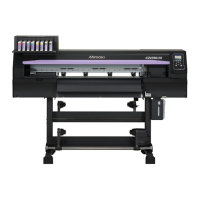© 2014 MIMAKI ENGINEERING CO.,LTD. 5.2.1 P.1
1
2
3
4
5
6
7
8
R.1.0
MAINTENANCE MANUAL > Test Items > Other Test > Determining short circuit of COM16 IO PCB/COM32 IO PCB
Model
CJV150/300
Issued
2014.09.15
Revised F/W ver
1.00
Remark
1.0
5.2.1
Determining short circuit of COM16 IO PCB/COM32 IO PCB
Outline
Check whether the COM circuit generating part of the COM16 IO PCB or COM32 IO PCB has electrical trouble or
not.
Procedure
1. In case of JV150 (COM16 IO PCB);
Release the top and bottom lock of the connector under the
CN27, CN28 and CN29 of the COM16 IO PCB, and disconnect
the FFC.
In case of JV300 (COM32 IO PCB);
Release the top and bottom lock of the connector under the
N27, CN28, CN29, CN30, and CN31 of the COM32 IO PCB,
and disconnect the FFC.
2. Measure a resistance between the test pin (TP) and GND on the
COM16/32 IO PCB ASSY to determine the COM circuit condi-
tion.
(1)In case of JV150 (COM16 IO PCB)
Connect the negative terminal of the tester to the GND test
pin and measure the resistance by getting the positive terminal
touch to TP with the following.
On the COM16 IO PCB,
TP under CN27 (TP1, 5, 2, 6, 9, 13, 10, 14),
TP under CN28 (TP3, 7, 4, 8, 11, 15, 12, 16)
After turning off the sub and main power switches in order, unplug the power code.
Check if no electric charge is remaining in the PCB.
It is very dangerous if sleep mode functions mistakenly during the operation.
Moreover, the PCB may be damaged in case electric charge still remains inside.
Also there is a possibility of electric shock because of high power voltage applied the high-pressure part
of PCB. Take care to avoid contact with it.
TP14
TP10
TP13
TP9
TP6
TP2
TP5
TP1
TP16
TP12
TP15
TP11
TP8
TP4
TP7
TP3
TP30
TP26
TP29
TP25
TP22
TP18
TP21
TP17
TP32
TP28
TP31
TP27
TP24
TP20
TP23
TP19
CN27 CN28
CN30 CN31

